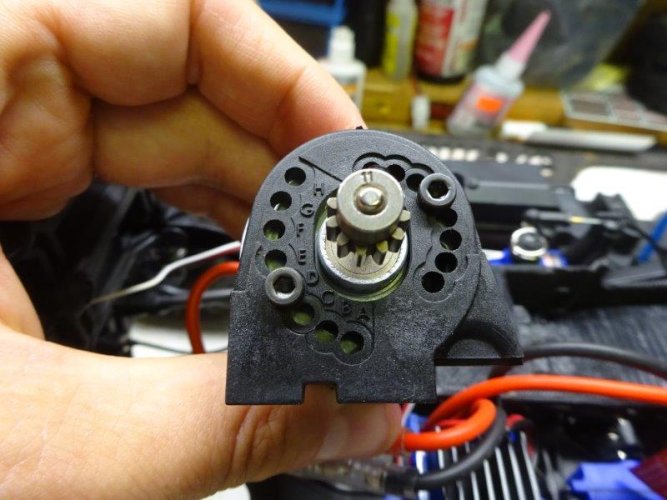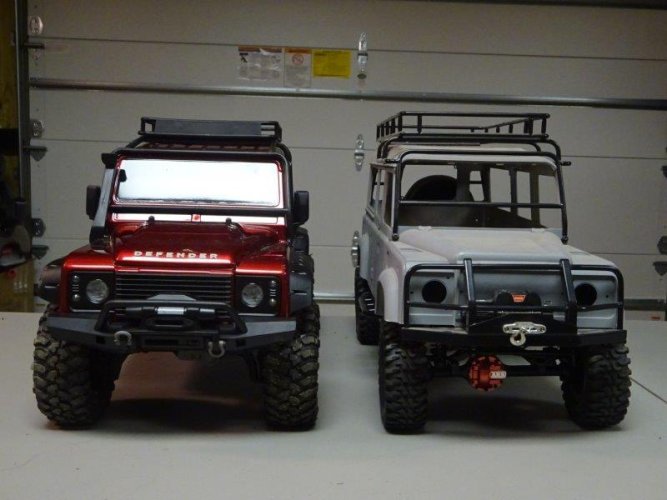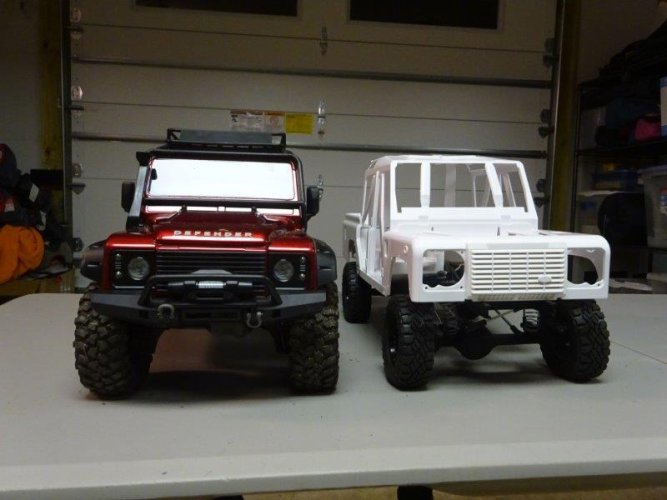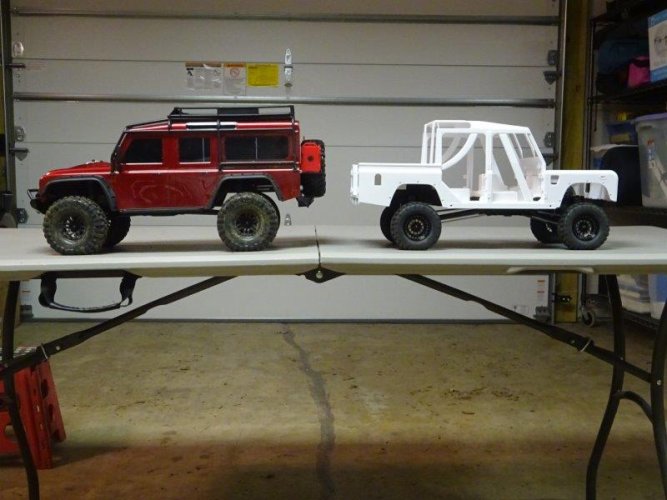new2rocks
I wanna be Dave
The much-anticipated Traxxas TRX-4 scale crawler is finally here, and it’s a good one. Traxxas clearly put lots of thought into the design and engineering of this all-new truck, and they have enhanced the platform since its initial release. I’ve started this guide to help you sort through the new features and components, and to help plan your inevitable mods and upgrades. Because this platform is still new, I’m intending this guide to be a work in progress as we learn from our collective experiences with the TRX-4.
Here’s what we’ll cover in the guide:
1. Overview of the TRX-4
2. Recommended performance upgrades
3. Transmission and driveline
4. Motor and ESC
5. Axles
6. Suspension
7. Electronics
8. Wheels and tires
9. Chassis
10. Body
11. Reserved for future
It's also worth having a good look at the Owner's Manual that Traxxas has posted on their website (but does not include in the box). The RTR version has some very helpful info:
https://traxxas.com/sites/default/files/82056-4-OM-EN-R02.pdf
And the kit version is a great resource if you need to take anything part for maintenance, repairs, upgrades, or just morbid curiosity:
https://traxxas.com/sites/default/files/KC2560-R01%20TRX-4%20Assembly%20Manual-WEB.pdf
If you have any questions, suggestions, or feedback, please let me know. Enjoy!
1. Overview of the TRX-4
The TRX-4 combines the familiar c-channel chassis architecture and linked suspension architecture with a host of features not typically found (some not previously found at all) in RTR scale crawlers. Some of the highlights include:
- 2-speed transmission
- Remote locking and unlocking front and rear differentials
- Portal axles for added ground clearance
- 45 degrees of steering
- Option to upgrade radio with Bluetooth programming capability
- Inner fenders included with stock body
The initial release of the TRX-4 included a licensed Land Rover Defender 110 polycarbonate body, with some great looking scale accessories bolted on (think roof rack, spare tire, jerry can, high lift, and faux winch):
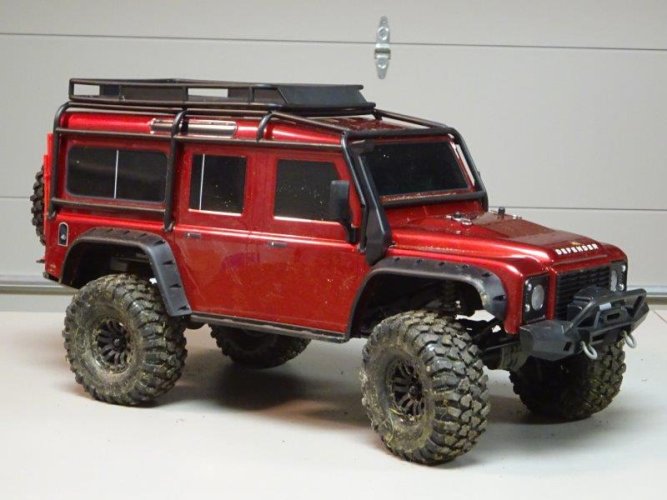
The only real letdown to the body is the use of stickers for “windows” instead of masking off inside the body before painting to leave the windows clear. From a functional perspective, the body feels very strong and should prove to be very durable out on the trails and rocks.
Traxxas followed this up with a licensed Ford Bronco that is simply stunning (and has clear windows!)...
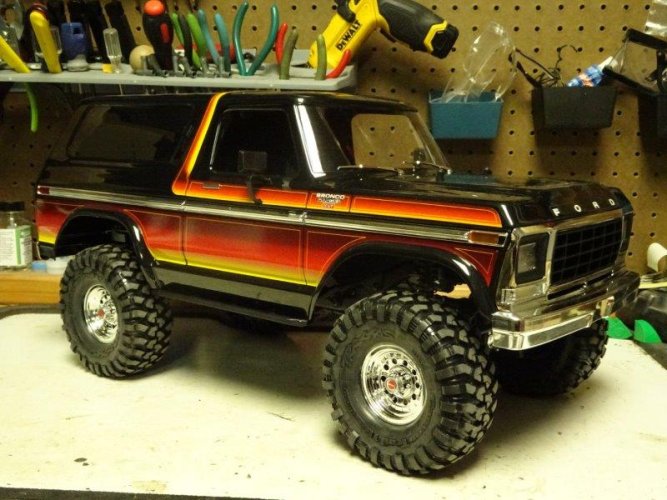
...along with a kit version. That's right...a KIT from Traxxas! "thumbsup" I Roo has already started on his:
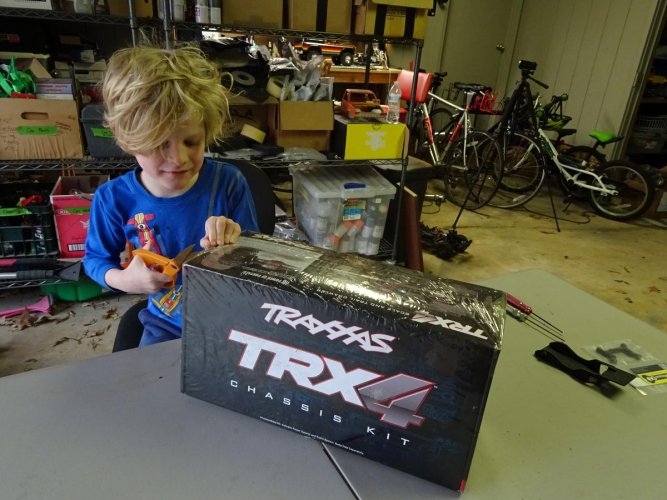
The kit version takes a different approach from the other big players by including electronics (radio, receiver, ESC, motor and servos) while leaving out the body. Here's a sneak peak at the kit from Roo:
https://www.facebook.com/BowHouseRC/videos/2010278995914018/
As Roo makes progress on his build, I'll be updating this guide with info on the kit.
Getting the RTR versions of the TRX-4 running is as simple as adding 4 AA batteries to the remote and a charged pack to the truck, turning it on, and heading off on the trails. But before you head out on any extended runs, we recommend taking a few preventative steps:
So how does it drive? Box stock, the TRX-4 is well balanced with a very smooth drivetrain and highly capable suspension. Even with the diffs unlocked, the TRX-4 is capable of handling most trailing and light crawling duties. With diffs locked, the TRX-4 turns into a highly capable crawler whose only major let down in stock form is the weak stock servo. But that’s an easy fix (for more on that, see below). Here's a short video I put together that shows the TRX-4 in action in a variety of terrain:
<iframe width="560" height="315" src="https://www.youtube.com/embed/2t_CQ70V7LQ" frameborder="0" allowfullscreen></iframe>
https://youtu.be/2t_CQ70V7LQ
Here are a links to a few helpful video reviews:
Harley Designs (good overview followed by other videos with more details):
<iframe width="560" height="315" src="https://www.youtube.com/embed/bUb9do5e_rU" frameborder="0" allowfullscreen></iframe>
https://youtu.be/bUb9do5e_rU
John Holmes of Holmes Hobbies (excellent technical overview):
<iframe width="560" height="315" src="https://www.youtube.com/embed/3ROIJ1E58jg" frameborder="0" allowfullscreen></iframe>
https://youtu.be/3ROIJ1E58jg
Matteo's RC (excellent demonstration of different features):
<iframe width="560" height="315" src="https://www.youtube.com/embed/dj6KBFL2NKs" frameborder="0" allowfullscreen></iframe>
https://youtu.be/dj6KBFL2NKs
And here's a link to a very good write-up from Big Squid RC, which is known as a bashing site but has added a lot more scaler content over the past year or so:
Traxxas TRX-4 Scale & Trail Crawler Review « Big Squid RC – News, Reviews, Videos, and More!
2. Recommended performance upgrades
Box stock is all well and good for a little while, but tinkering will be necessary in some cases and, in others, a lot more than half the fun. When looking to improve the performance of your TRX-4, there are two areas where you will notice the biggest and most immediate differences:
As you’re starting to consider the options, there is one important limiting factor to keep in mind. If you’re planning to keep the stock axles, your body and wheel/tire choices will be limited by the width of the stock axles and size of the portal knuckles. Simply put, the TRX-4 axles wouldn’t look right under most narrow to medium-width bodies, which pretty much eliminates using this as a class 1 truck with the stock axles. But that still leaves tons of options for making the TRX-4 your own as a class 2 truck, so let’s get on with it…
Here’s what we’ll cover in the guide:
1. Overview of the TRX-4
2. Recommended performance upgrades
3. Transmission and driveline
4. Motor and ESC
5. Axles
6. Suspension
7. Electronics
8. Wheels and tires
9. Chassis
10. Body
11. Reserved for future
It's also worth having a good look at the Owner's Manual that Traxxas has posted on their website (but does not include in the box). The RTR version has some very helpful info:
https://traxxas.com/sites/default/files/82056-4-OM-EN-R02.pdf
And the kit version is a great resource if you need to take anything part for maintenance, repairs, upgrades, or just morbid curiosity:
https://traxxas.com/sites/default/files/KC2560-R01%20TRX-4%20Assembly%20Manual-WEB.pdf
If you have any questions, suggestions, or feedback, please let me know. Enjoy!
1. Overview of the TRX-4
The TRX-4 combines the familiar c-channel chassis architecture and linked suspension architecture with a host of features not typically found (some not previously found at all) in RTR scale crawlers. Some of the highlights include:
- 2-speed transmission
- Remote locking and unlocking front and rear differentials
- Portal axles for added ground clearance
- 45 degrees of steering
- Option to upgrade radio with Bluetooth programming capability
- Inner fenders included with stock body
The initial release of the TRX-4 included a licensed Land Rover Defender 110 polycarbonate body, with some great looking scale accessories bolted on (think roof rack, spare tire, jerry can, high lift, and faux winch):

The only real letdown to the body is the use of stickers for “windows” instead of masking off inside the body before painting to leave the windows clear. From a functional perspective, the body feels very strong and should prove to be very durable out on the trails and rocks.
Traxxas followed this up with a licensed Ford Bronco that is simply stunning (and has clear windows!)...

...along with a kit version. That's right...a KIT from Traxxas! "thumbsup" I Roo has already started on his:

The kit version takes a different approach from the other big players by including electronics (radio, receiver, ESC, motor and servos) while leaving out the body. Here's a sneak peak at the kit from Roo:
https://www.facebook.com/BowHouseRC/videos/2010278995914018/
As Roo makes progress on his build, I'll be updating this guide with info on the kit.
Getting the RTR versions of the TRX-4 running is as simple as adding 4 AA batteries to the remote and a charged pack to the truck, turning it on, and heading off on the trails. But before you head out on any extended runs, we recommend taking a few preventative steps:
1. Check the pinion gear placement and pinion/spur mesh (see transmission section below)
2. Check the diff, tranny and transfer case gears for grease. Greasing from the factory in early production models has been hit or miss, which isn't uncommon with RTRs. Cases shouldn't be packed with grease, but there should be enough grease to give the gears a nice, full coating.
3. Check your steering endpoints. There have been a few early reports of snapped CVDs, most likely due to oversteering the axles.
2. Check the diff, tranny and transfer case gears for grease. Greasing from the factory in early production models has been hit or miss, which isn't uncommon with RTRs. Cases shouldn't be packed with grease, but there should be enough grease to give the gears a nice, full coating.
3. Check your steering endpoints. There have been a few early reports of snapped CVDs, most likely due to oversteering the axles.
So how does it drive? Box stock, the TRX-4 is well balanced with a very smooth drivetrain and highly capable suspension. Even with the diffs unlocked, the TRX-4 is capable of handling most trailing and light crawling duties. With diffs locked, the TRX-4 turns into a highly capable crawler whose only major let down in stock form is the weak stock servo. But that’s an easy fix (for more on that, see below). Here's a short video I put together that shows the TRX-4 in action in a variety of terrain:
<iframe width="560" height="315" src="https://www.youtube.com/embed/2t_CQ70V7LQ" frameborder="0" allowfullscreen></iframe>
https://youtu.be/2t_CQ70V7LQ
Here are a links to a few helpful video reviews:
Harley Designs (good overview followed by other videos with more details):
<iframe width="560" height="315" src="https://www.youtube.com/embed/bUb9do5e_rU" frameborder="0" allowfullscreen></iframe>
https://youtu.be/bUb9do5e_rU
John Holmes of Holmes Hobbies (excellent technical overview):
<iframe width="560" height="315" src="https://www.youtube.com/embed/3ROIJ1E58jg" frameborder="0" allowfullscreen></iframe>
https://youtu.be/3ROIJ1E58jg
Matteo's RC (excellent demonstration of different features):
<iframe width="560" height="315" src="https://www.youtube.com/embed/dj6KBFL2NKs" frameborder="0" allowfullscreen></iframe>
https://youtu.be/dj6KBFL2NKs
And here's a link to a very good write-up from Big Squid RC, which is known as a bashing site but has added a lot more scaler content over the past year or so:
Traxxas TRX-4 Scale & Trail Crawler Review « Big Squid RC – News, Reviews, Videos, and More!
2. Recommended performance upgrades
Box stock is all well and good for a little while, but tinkering will be necessary in some cases and, in others, a lot more than half the fun. When looking to improve the performance of your TRX-4, there are two areas where you will notice the biggest and most immediate differences:
1. Steering servo - The very first thing you should do is replace the stock steering servo, which is very underpowered (only 125 oz-inch / 9.0 kg-cm of torque). I recommend 250 oz-inch at a minimum, but 300-350 is even better. The Holmes Hobbies SHV500 is a great option because it can run directly off of 2S or 3S battery power using the auxiliary JST power plug that comes on the XL-5 ESC.
2. Lower the Center of Gravity - Straight out of the box, the TRX-4 has a relatively high center of gravity due to the combination of high battery placement relative to the chassis, portal axles, tall shocks, and top-heavy bodies (esp. the Defender 110 body). There are a variety of ways to lower the CG, including a low CG battery tray, adding brass portal components, running shorter shocks, choosing a body with a lower CG, and adding weight to the wheels. If you were going to choose two, I'd recommend lowering the battery and running shorter shocks. And I'd put adding weight to the wheels last on the list, in part because it can add stress to the driveline. But whatever you do, find a way to lower the CG. It will make a big difference.
2. Lower the Center of Gravity - Straight out of the box, the TRX-4 has a relatively high center of gravity due to the combination of high battery placement relative to the chassis, portal axles, tall shocks, and top-heavy bodies (esp. the Defender 110 body). There are a variety of ways to lower the CG, including a low CG battery tray, adding brass portal components, running shorter shocks, choosing a body with a lower CG, and adding weight to the wheels. If you were going to choose two, I'd recommend lowering the battery and running shorter shocks. And I'd put adding weight to the wheels last on the list, in part because it can add stress to the driveline. But whatever you do, find a way to lower the CG. It will make a big difference.
As you’re starting to consider the options, there is one important limiting factor to keep in mind. If you’re planning to keep the stock axles, your body and wheel/tire choices will be limited by the width of the stock axles and size of the portal knuckles. Simply put, the TRX-4 axles wouldn’t look right under most narrow to medium-width bodies, which pretty much eliminates using this as a class 1 truck with the stock axles. But that still leaves tons of options for making the TRX-4 your own as a class 2 truck, so let’s get on with it…
Last edited:



